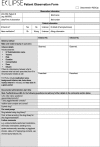Exploring the Current Landscape of Intravenous Infusion Practices and Errors (ECLIPSE): protocol for a mixed-methods observational study
- PMID: 26940104
- PMCID: PMC4785301
- DOI: 10.1136/bmjopen-2015-009777
Exploring the Current Landscape of Intravenous Infusion Practices and Errors (ECLIPSE): protocol for a mixed-methods observational study
Abstract
Introduction: Intravenous medication is essential for many hospital inpatients. However, providing intravenous therapy is complex and errors are common. 'Smart pumps' incorporating dose error reduction software have been widely advocated to reduce error. However, little is known about their effect on patient safety, how they are used or their likely impact. This study will explore the landscape of intravenous medication infusion practices and errors in English hospitals and how smart pumps may relate to the prevalence of medication administration errors.
Methods and analysis: This is a mixed-methods study involving an observational quantitative point prevalence study to determine the frequency and types of errors that occur in the infusion of intravenous medication, and qualitative interviews with hospital staff to better understand infusion practices and the contexts in which errors occur. The study will involve 5 clinical areas (critical care, general medicine, general surgery, paediatrics and oncology), across 14 purposively sampled acute hospitals and 2 paediatric hospitals to cover a range of intravenous infusion practices. Data collectors will compare each infusion running at the time of data collection against the patient's medication orders to identify any discrepancies. The potential clinical importance of errors will be assessed. Quantitative data will be analysed descriptively; interviews will be analysed using thematic analysis.
Ethics and dissemination: Ethical approval has been obtained from an NHS Research Ethics Committee (14/SC/0290); local approvals will be sought from each participating organisation. Findings will be published in peer-reviewed journals and presented at conferences for academic and health professional audiences. Results will also be fed back to participating organisations to inform local policy, training and procurement. Aggregated findings will inform the debate on costs and benefits of the NHS investing in smart pump technology, and what other changes may need to be made to ensure effectiveness of such an investment.
Keywords: AUDIT.
Published by the BMJ Publishing Group Limited. For permission to use (where not already granted under a licence) please go to http://www.bmj.com/company/products-services/rights-and-licensing/
Figures
Similar articles
-
Procedural and documentation variations in intravenous infusion administration: a mixed methods study of policy and practice across 16 hospital trusts in England.BMC Health Serv Res. 2018 Apr 10;18(1):270. doi: 10.1186/s12913-018-3025-x. BMC Health Serv Res. 2018. PMID: 29636034 Free PMC article.
-
Intravenous infusion practices across England and their impact on patient safety: a mixed-methods observational study.Southampton (UK): NIHR Journals Library; 2020 Feb. Southampton (UK): NIHR Journals Library; 2020 Feb. PMID: 32040286 Free Books & Documents. Review.
-
Errors and discrepancies in the administration of intravenous infusions: a mixed methods multihospital observational study.BMJ Qual Saf. 2018 Nov;27(11):892-901. doi: 10.1136/bmjqs-2017-007476. Epub 2018 Apr 7. BMJ Qual Saf. 2018. PMID: 29627799 Free PMC article.
-
System-Level Patient Safety Practices That Aim to Reduce Medication Errors Associated With Infusion Pumps: An Evidence Review.J Patient Saf. 2020 Sep;16(3S Suppl 1):S42-S47. doi: 10.1097/PTS.0000000000000722. J Patient Saf. 2020. PMID: 32810000 Free PMC article. Review.
-
Understanding safety differently: developing a model of resilience in the use of intravenous insulin infusions in hospital in-patients-a feasibility study protocol.BMJ Open. 2019 Jul 10;9(7):e029997. doi: 10.1136/bmjopen-2019-029997. BMJ Open. 2019. PMID: 31296514 Free PMC article.
Cited by
-
How external and internal resources influence user action: the case of infusion devices.Cogn Technol Work. 2016;18(4):793-805. doi: 10.1007/s10111-016-0392-0. Epub 2016 Sep 21. Cogn Technol Work. 2016. PMID: 32355464 Free PMC article.
-
Patient and public involvement in patient safety research: a workshop to review patient information, minimise psychological risk and inform research.Res Involv Engagem. 2016 May 17;2:19. doi: 10.1186/s40900-016-0035-x. eCollection 2016. Res Involv Engagem. 2016. PMID: 29062520 Free PMC article.
-
Intravenous Infusion Administration: A Comparative Study of Practices and Errors Between the United States and England and Their Implications for Patient Safety.Drug Saf. 2019 Oct;42(10):1157-1165. doi: 10.1007/s40264-019-00841-2. Drug Saf. 2019. PMID: 31197746 Free PMC article.
-
Intravenous drug use in neonatal intensive care units.Eur J Hosp Pharm. 2021 Nov;28(6):341-345. doi: 10.1136/ejhpharm-2019-001939. Epub 2019 Nov 21. Eur J Hosp Pharm. 2021. PMID: 34697051 Free PMC article.
-
Procedural and documentation variations in intravenous infusion administration: a mixed methods study of policy and practice across 16 hospital trusts in England.BMC Health Serv Res. 2018 Apr 10;18(1):270. doi: 10.1186/s12913-018-3025-x. BMC Health Serv Res. 2018. PMID: 29636034 Free PMC article.
References
-
- AAMI/FDA. Infusing Patients Safely: Priority Issues from the AAMI/FDA Infusion Device Summit. 2010. http://tinyurl.com/46l7ynq (accessed 29 Jul 2015).
Publication types
MeSH terms
Grants and funding
LinkOut - more resources
Full Text Sources
Other Literature Sources
Medical

